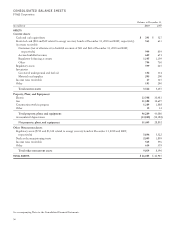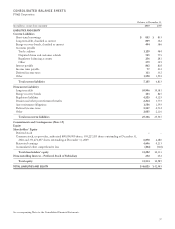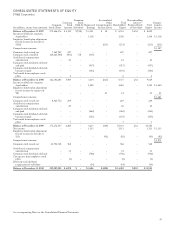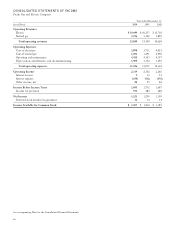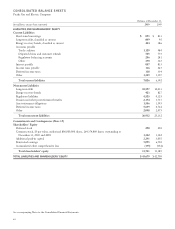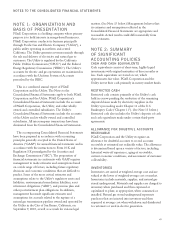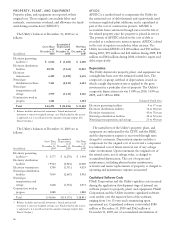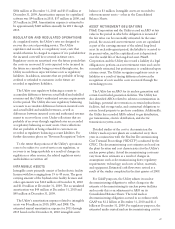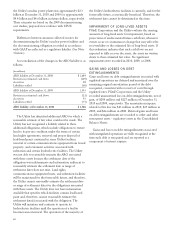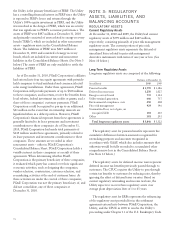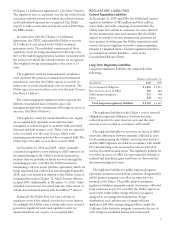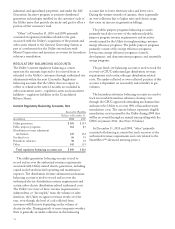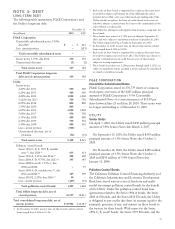PG&E 2010 Annual Report Download - page 69
Download and view the complete annual report
Please find page 69 of the 2010 PG&E annual report below. You can navigate through the pages in the report by either clicking on the pages listed below, or by using the keyword search tool below to find specific information within the annual report.NOTES TO THE CONSOLIDATED FINANCIAL STATEMENTS
NOTE 1: ORGANIZATION AND
BASIS OF PRESENTATION
PG&E Corporation is a holding company whose primary
purpose is to hold interests in energy-based businesses.
PG&E Corporation conducts its business principally
through Pacific Gas and Electric Company (“Utility”), a
public utility operating in northern and central
California. The Utility generates revenues mainly through
the sale and delivery of electricity and natural gas to
customers. The Utility is regulated by the California
Public Utilities Commission (“CPUC”) and the Federal
Energy Regulatory Commission (“FERC”). The Utility’s
accounts for electric and gas operations are maintained in
accordance with the Uniform System of Accounts
prescribed by the FERC.
This is a combined annual report of PG&E
Corporation and the Utility. The Notes to the
Consolidated Financial Statements apply to both PG&E
Corporation and the Utility. PG&E Corporation’s
Consolidated Financial Statements include the accounts
of PG&E Corporation, the Utility, and other wholly
owned and controlled subsidiaries. The Utility’s
Consolidated Financial Statements include the accounts
of the Utility and its wholly owned and controlled
subsidiaries. All intercompany transactions have been
eliminated from the Consolidated Financial Statements.
The accompanying Consolidated Financial Statements
have been prepared in accordance with accounting
principles generally accepted in the United States of
America (“GAAP”) for annual financial statements and in
accordance with the instructions to Form 10-K and
Regulation S-X promulgated by the Securities and
Exchange Commission (“SEC”). The preparation of
financial statements in conformity with GAAP requires
management to make estimates and assumptions based
on a wide range of factors, including future regulatory
decisions and economic conditions that are difficult to
predict. Some of the more critical estimates and
assumptions relate to the Utility’s regulatory assets and
liabilities, environmental remediation liabilities, asset
retirement obligations (“ARO”), and pension plan and
other postretirement plan obligations. In addition,
management has made significant estimates and
assumptions for accruals related to the rupture of a
natural gas transmission pipeline owned and operated by
the Utility in the City of San Bruno, California, on
September 9, 2010, as well as accruals for various legal
matters. (See Note 15 below.) Management believes that
its estimates and assumptions reflected in the
Consolidated Financial Statements are appropriate and
reasonable. Actual results could differ materially from
those estimates.
NOTE 2: SUMMARY
OF SIGNIFICANT
ACCOUNTING POLICIES
CASH AND CASH EQUIVALENTS
Cash equivalents consist of short-term, highly liquid
investments with original maturities of three months or
less. Cash equivalents are stated at cost, which
approximates fair value. PG&E Corporation and the
Utility invest their cash primarily in money market funds.
RESTRICTED CASH
Restricted cash consists primarily of the Utility’s cash
held in escrow pending the resolution of the remaining
disputed claims made by electricity suppliers in the
Utility’s proceeding under Chapter 11 of the U.S.
Bankruptcy Code (“Chapter 11”). (See Note 13 below.)
Restricted cash also includes the Utility’s deposits of cash
and cash equivalents made under certain third-party
agreements.
ALLOWANCE FOR DOUBTFUL ACCOUNTS
RECEIVABLE
PG&E Corporation and the Utility recognize an
allowance for doubtful accounts to record accounts
receivable at estimated net realizable value. The allowance
is determined based upon a variety of factors, including
historical write-off experience, aging of receivables,
current economic conditions, and assessment of customer
collectability.
INVENTORIES
Inventories are carried at weighted average cost and are
valued at the lower of weighted-average cost or market.
Inventories include materials, supplies, and natural gas
stored underground. Materials and supplies are charged to
inventory when purchased and then expensed or
capitalized to plant, as appropriate, when consumed or
installed. Natural gas stored underground represents
purchases that are injected into inventory and then
expensed at average cost when withdrawn and distributed
to customers or used in electric generation.
65



